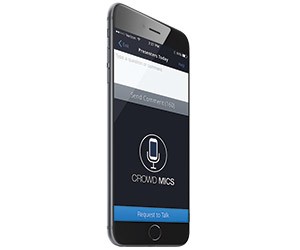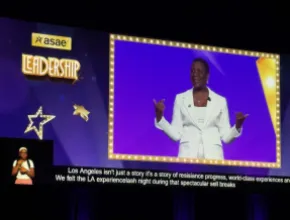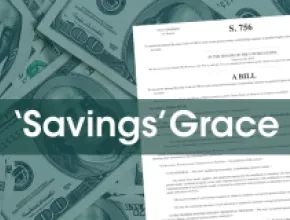Associations are in a bind. Their missions—and their events—almost always include attendee education and entertainment. But today’s show-goers are demanding. Millennials expect events to move at the same speed as their device-enabled, electronically enhanced lives. Gen Xers and Boomers aren’t far behind.
But while event formats remain firmly anchored in the old “one-to-many” paradigm, with one speaker talking to many attendees, ample technology now exists to take this dynamic to an interactive level. And now, only seriously old-school speakers feel threatened by audiences immersing themselves in e-mail, games, even fact-checking when speeches lag.
“I don’t ask people to put away their phones, I tell them to keep them out,” says technology speaker and consultant Corbin Ball, CSP, CMP, DES, MS. “It’s my job to keep the audience engaged. If I’m not, they have every right to check e-mail or whatever while I’m talking. And if I am, those phones and tablets become engagement tools that help me capture, hold and direct attention.”
The Engagement Toolbox
“Our members are hungry for information,” says Patty Ceglio, conference coordinator for the Seasonal Human Resources Association and Seasonal HR Specialist for recruiting agency CoolWorks.com. “But a poor presentation endangers learning. We have had employment specialists who know their stuff but don’t know how to engage their audience. That makes for a painful four hours. Others can walk into the room and have you wishing for more when the session ends. Our number-one need is for presenters who meet and beat audience expectations.”
Presenters and planners have a growing set of tools to help them do just that. Simply changing the way we talk about events and audiences can make a difference.
“Attendee is not the proper word,” Ball says. “We should all be talking about and thinking about participants. The audience today expects interaction. I use technology tools because I talk about technology. There are many ways to engage your audience.”
Even the much-maligned PowerPoint can be an effective engagement tool. Ball uses slide decks extensively, but rarely bullet points. His slide decks focus on photos, graphics and embedded video and audio. Mobile apps play a growing role.
AskQ boosts engagement by allowing the audience to ask questions online, then vote for questions and rank them by greatest interest. Crowd Mics hooks phones and tablets into the room sound system, turning them into microphones. The app also allows text comments and real-time polling. Presenters can grant access for one audience mic at a time or allow open mic access.
Karen Shackman, founder of Manhattan-based DMC Shackman Associates in New York, likes QnA, an app that lets participants text questions, poll responses and feedback in real time. Session moderators approve, prioritize or close questions on their own screens. Approved questions post to a public screen during presentations or Q&A sessions—no more roaming mics, garbled questions or rambling diatribes from the audience.
Topi allows planners and participants to connect with interest groups, conduct private chats, connect via LinkedIn and view profiles of other participants before, during and after an event. As apps become geo-aware, they can help participants enhance the experience based on physical location.
“If you have downtime between sessions, apps can let you know that a participant you were hoping to find for networking is down the street at Starbucks,” Shackman says. “We are seeing apps that create a hyper-intelligent private system that increases face-to-face interaction.”
PageBreak
Think Like a Magician
Other presenters prefer to use non-electronic tools. Kostya Kimlat uses sleight-of-hand magic.
“My goal is to engage and entertain,” says the founder of Event Magic International. “I want the audience to have so much fun they don’t even realize they are learning.”
Kimlat wanders the floor during the opening reception giving five-minute magic shows for tables and small conversational groups. Magic is something that people watch actively, he says. The more they watch, the more they engage. Each mini-show ends with Kimlat promising to reveal the secrets behind the tricks participants just saw during the keynote presentation the next morning.
“I get them excited about getting up early and coming to the event the next day,” he says. “When they get there, I talk about how to think like a magician. People think magicians misdirect your attention. What we really do is direct and lead your attention in specific directions. Good planners have developed their own set of tricks to direct attendees’ attention to very specific themes and events during the meeting.”
Meeting design can be a key trick. Traditional planners trot out last year’s program, tweak signage and colors and logos, adjust as needed for the current budget and start slotting the familiar pieces into their familiar slots. It can be more effective to put the current destination front and center.
“People want to know why they are traveling to an event,” explains Jessie States, manager of professional development for MPI. “They don’t want to see ballrooms that could be anywhere. They want local stories and experiences. It takes time to change a design format, but local inspiration and active involvement will increase your return on the meeting investment.”
Careful scheduling also boosts the meeting ROI. Association events are typically focused on education and learning, but much of the lasting value comes from individual and small-group networking. Effective networking takes both time and the right venue.
“We schedule social networking time,” says Jim Tedford, president and CEO of the Society of Animal Welfare Administrators (SAWA). “Our members know they will have plenty of play time, just no downtime, at our meetings.”
SAWA also wraps evening activities early to create time for informal networking. More importantly, the group chooses host hotels in part based on physical designs that encourage informal mingling in lobbies, bars and other public spaces.
“We look for facilities that make it easy for us to come together spontaneously,” he says. “Animal welfare is a fairly small field. All it takes is a conducive space and we keep each other engaged.”
Bryan Mattimore, co-founder of innovation agency Growth Engine, takes a more hands-on approach. He uses ideation techniques designed to get attendees physically and intellectually engaged. One of the most successful is “brainwalking.”
Participants write an idea for the group to consider on sheets of flip chart paper posted on a wall. Everyone then moves to the next sheet and either builds on the original idea or uses it to trigger something entirely different. The group then repeats the exercise until everyone has visited multiple sheets.
“This is a way to involve everyone in your group,” he says. “Extroverts love it because they are up and talking. Introverts jump in because all they have to do is think and write and play off all the ideas that are popping up without presenting to the group. When you go to an association event, there is a tremendous amount of talent in the room. To have one expert talking at you for an hour is a waste of all that talent. Yes, you have to give up some control when you bring in this kind of interactive design, but you gain far more than you risk.”
FRED GEBHART has been associated with Meetings Focus for many years and covers countless meeting topics.






